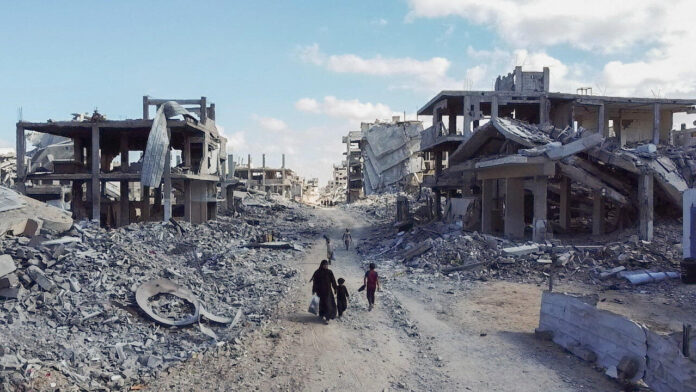Israel returned the bodies of 15 Palestinians to Gaza on Saturday, bringing the total number handed over to 135, the health ministry in the Hamas-run territory said.
The Gaza health ministry said that some of the bodies returned on Saturday bore signs of “abuse, beatings, handcuffing and blindfolding”.
The Israeli military has said these claims were “Hamas’s false propaganda”.
“Furthermore, all the bodies returned so far are from combatants within the Gaza Strip,” it told AFP on Friday.
Under a ceasefire deal brokered by US President Donald Trump, Israel was to turn over the bodies of 15 Palestinians for every deceased Israeli returned.
Late on Friday, Hamas handed over the body of another Israeli hostage, who Israel identified as Eliyahu Margalit.
Israel’s Prime Minister’s Office said Saturday that Margalit’s body was identified after testing by the National Center for Forensic Medicine and his family has been notified. The 76-year-old was abducted on Oct. 7, 2023, when Hamas attacked Israel, from the horse stables where he worked in Kibbutz Nir Oz.
Margalit’s body was found after two bulldozers plowed up pits in the earth in the city of Khan Younis.
Margalit is the 10th returned hostage body since the ceasefire went into effect over a week ago. Hamas handed over an 11th body this week, but it wasn’t that of a hostage. The effort to find the remains followed a warning from US President Donald Trump that he would green-light Israel to resume the war if Hamas doesn’t live up to its end of the deal and return all hostages’ bodies, totaling 28.
Read moreHome but forever changed, Israel’s freed hostages begin the long road to recovery
In a statement Saturday, the hostage forum, which supports the families of those abducted, said Margalit’s return brings a measure of solace to his family, but that they won’t rest until the remaining 18 hostages come home. The forum says it will continue holding weekly rallies until all remains are returned.
Since the ceasefire began, Hamas has handed over the bodies of nine Israelis and one Nepalese student.
The handover of hostages‘ remains, called for under the ceasefire agreement, has been among the key sticking points – along with aid deliveries, the opening of border crossings into Gaza and hopes for reconstruction – in a process backed by much of the international community to help end two years of devastating war in Gaza.
Hamas has said it is committed to the terms of the ceasefire deal, including the handover of bodies. However, the retrieval of bodies is hampered by the scope of the devastation and the presence of dangerous, unexploded ordnance. The group has also told mediators that some bodies are in areas controlled by Israeli troops.
Also on Saturday the ministry of health said that more than 68,000 Palestinians have been killed in the two-year-long war. The ministry said the number of dead has climbed since the ceasefire went into effect, with the majority of the newly counted dead bodies being found during recovery efforts under the rubble.
Meanwhile, Hamas is accusing Israel of continuing its attacks and violating the ceasefire.
Read moreA week into fragile ceasefire, people of Gaza ‘have started to breathe again’
Nine Palestinians killed by Israeli fire
On Friday the Civil Defense, a first responders’ agency operating under the Hamas-run interior ministry, said nine people were killed, including women and children, when their vehicle was hit by Israeli fire in Gaza City. The Civil Defense said the car crossed into an Israeli controlled area in eastern Gaza.
As part of the first phase of the ceasefire, Israel still maintains control of about half of Gaza.
The Civil Defense said that Israel could have warned the people in a manner that wasn’t lethal. The group recovered the bodies on Saturday with coordination from the UN, it said.
Israel’s army said it saw a “suspicious vehicle” crossing the yellow line and approaching the army’s troops. It said it fired warning shots but the vehicle continued to approach in a manner that posed an “imminent threat.” It said it acted in accordance with the ceasefire.
Hamas is also urging mediators to increase the flow of aid into Gaza, expedite the opening of the Rafah border crossing with Egypt and start reconstruction of the battered territory.
The flow of aid remains constrained because of continued closures of crossings and restrictions on aid groups.
One of your browser extensions seems to be blocking the video player from loading. To watch this content, you may need to disable it on this site.

United Nations data on Friday showed 339 trucks have been offloaded for distribution in Gaza since the ceasefire began a week ago. Under the agreement, some 600 humanitarian aid trucks would be allowed to enter each day.
COGAT, the Israeli defense body overseeing aid in Gaza, reported 950 trucks – including commercial trucks and bilateral deliveries – crossing on Thursday and 716 on Wednesday, the UN said
Gaza’s more than 2 million people are hoping the ceasefire will bring relief from the humanitarian disaster caused by Israel’s offensive. Throughout the war, Israel restricted aid entry to Gaza – sometimes halting it altogether.
Famine was declared in Gaza City, and the UN says it has verified more than 400 people who died of malnutrition-related causes, including more than 100 children.
Israel says it let in enough food, accusing Hamas of stealing much of it. The UN and other aid agencies deny the claim.
Israel’s campaign in Gaza has killed nearly 68,000 Palestinians, according to the health ministry, which is part of the Hamas-run government in the territory. Its figures are seen as a reliable estimate of wartime deaths by UN agencies and many independent experts. Israel has disputed them without providing its own toll.
Thousands more people are missing, according to the Red Cross.
UN aid chief foresees ‘massive job’ in Gaza
In a short convoy of white jeeps, United Nations relief coordinator Tom Fletcher and his team wound their way through the twisted rubble of shattered homes to inspect a wastewater treatment plant in Sheikh Radwan, north of Gaza City on Saturday.
“I drove through here seven to eight months ago when most of these buildings were still standing and, to see the devastation, this is a vast part of the city, just a wasteland, and it’s absolutely devastating to see,” he told AFP.
Surveying the damaged pumping equipment and a grim lake of sewage at the Sheikh Radwan wastewater plant, Fletcher said the task ahead for the UN and aid agencies was a “massive, massive job”.
“We have a massive 60 day plan now to surge in food, get a million meals out there a day, start to rebuild the health sector, bring in tents for the winter, get hundreds of thousands of kids back into school.”
Relief agencies have called for the Rafah border crossing from Egypt to be reopened to speed the flow of food, fuel and medicines, and Turkey has a team of rescue specialists waiting at the border to help find bodies in the rubble.
(FRANCE 24 with AP and AFP)
Source link






